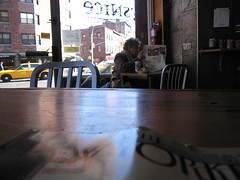South:
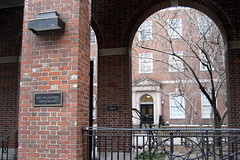
40: NYU's Vanderbilt Law School, built 1951, destroyed a number of historic buildings:
38 (corner):
Eugene O'Neill, fresh from having his first play produced in Provincetown, Mass., moved into a
building here in 1916. While living here he had an affair with
Louise Bryant, while her husband, radical journalist John
Reed, was in the hospital.
42:
John Reed lived here when he first moved to Greenwich Village as a 23-year-old Harvard
grad. Muckraker
Lincoln Steffans moved into the apartment below him. In 1913, Reed moved out to live with socialite Mabel
Dodge on Fifth Avenue.
43: John Reed lived here in 1916 when
Louise Bryant left her husband to come live with him.
They got married
while living here, and left from here in 1917 to
report on the Russian Revolution.
|
|
50 (corner): NYU's
Hagop Kevorkian Center for Near Eastern Studies,
designed in 1972 by Philip Johnson. The entrance hall is
a reproduction of the interior of a 1797 merchant's house in Damascus.
51: Heyman Hall houses the
Skirball
Department of Hebrew & Judaic Studies, as well
as the
Goldstein-Goren Center for American-Jewish
History.
53: Judson Hall. Once part of the church; now NYU's
King Juan Carlos of Spain Center, promoting Spanish and Latin
American Studies. Painter
John Sloan once had a studio here.
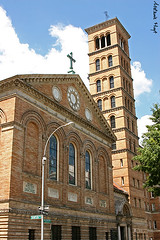
54-57 (corner): Judson Memorial Baptist Church, built 1888-96 from a Stanford White design inspired by early Christian churches. Founded by
Edward Judson, the church has always been socially active, providing services for the immigrant neighborhood at the turn of the 20th Century. During the 1960s,
the church provided drug treatment, draft counseling and abortion referrals. It provided sanctuary from police during 1961's Folksinger Riots. In 1992, ACT-UP
held an open-casket funeral here that carried the body of AIDS activist Mark Fisher to George Bush the Elder's re-election headquarters on 43rd Street.
Poet Edwin Arlington Robinson lived in Judson's tower in 1906.
|
|
58 (corner): Holy Trinity Chapel (1964);
"awkward modernism," says AIA Guide. Houses the
Catholic Center
at NYU; formerly named for Generoso Pope, an
editor and a friend of Mussolini's.
Built on the site of the house of Daniel
Megie, the state hangman, who handled the executions
at Washington Square's
Hanging Elm. The house later became Bruno's
Garrett, a sort of Bohemian theme park run by Village
character Guido Bruno.
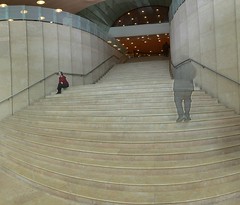
61 (corner): Kimmel Center for University Life (2001);
"borders on the grotesque"--AIA Guide. Replaced the
Loeb Student
Center (1958), where Bob Dylan had his first
paid gig in 1961, and which served as
the command center for the NYU student strike that followed Nixon's
1970 invasion of Cambodia.
Loeb in turn was built on the
site of Katharine Branchard's House of Genius, a boardinghouse
whose tenants are said to have included virtually every
Village literary figure--the ones who actually lived here were
Frank Norris and Allan Seeger.
60: At this defunct address, novelist
Willa Cather
lived in 1906-08, where she met her life partner Edith Lewis; here also
Robert W. Chambers wrote
The King in Yellow, a series of very disturbing short stories.
63: British occultist
Aleister Crowley
lived at this former address in 1918-19,
moving to a studio here because he had taken up
painting, seeking ''DWARFS,
HUNCHBACKS, Tatooed Women,
Harrison Fisher Girls,
Freaks of All Sorts'' to pose for him. He held a
party here called the Benzine Jag, to which he invited ''the
representatives of the Press, the Prohibition
Movement, the Pulpit, Poetry and the Police.''
|
Bobst Library

70 Wash-ington Square South (corner): NYU's main library,
built in 1972 to a Philip Johnson design; at the time, the plan was to
redo all of NYU in this
red sandstone look. Named
for Nixon supporter, antisemite and child molester
Elmer Holmes Bobst; a corrupt contribution from Bobst to Nixon
is supposedly responsible for the selection of Spiro Agnew
as Nixon's running mate.
 Lili Taylor studies here in The Addiction. At least two real-life NYU students have committed suicide by
leaping down the central atrium. If you want
to go inside, tell the guard that you're going to the
Tamiment Labor Library on the 10th floor, which
unlike the rest of the library is open to the public.
Lili Taylor studies here in The Addiction. At least two real-life NYU students have committed suicide by
leaping down the central atrium. If you want
to go inside, tell the guard that you're going to the
Tamiment Labor Library on the 10th floor, which
unlike the rest of the library is open to the public.
72: When Marie Guinan first came
to New York in 1907 from Waco, Texas, she
lived in a $2/week room in a boardinghouse
at
this address. She later became
Texas Guinan, movie cowgirl and
noted speakeasy hostess.
Schwartz Plaza

This open space provides a short-cut to
3rd Street. Includes the Founder's Memorial,
made from stonework from NYU's old Main Building.
50 W 4th St: Shimkin Hall
44: Kaufman Management Center.
42: Visiting a brothel at this address
as part of his 1892 investigation of New York vice,
the
Rev. Charles Parkhurst witnessed some kind
of sex show here that he was too embarrassed to describe.

40: Tisch Hall/Stern School of Business. More of
Johnson's red sandstone (1972). Space in front is Gould Plaza,
featuring Jean Arp's Seuil Configuration,
which looks like a silver jigsaw puzzle piece.
The 1990s building with the cylindrical
entrance is Stern School's New Building.
Corner (251 Mercer): Courant Institute/Warren Weaver
Hall (1966). In May 1970, 200 students protesting NYU's ties to the
nuclear industry held the $3.5 million computer here
hostage, demanding $100,000 for the Black Panthers' jail fund. When
NYU refused to pay up, students from SDS tried to blow
the computer up, but their Molotov cocktails were
extinguished before any damage was done.
|
|
|
North:
Washington Square Park
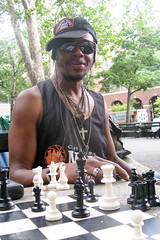
In the southwest corner of the park the chess players
can be found who were featured in Searching for
Bobby Fischer.

Originally a marsh surrounding Minetta Brook,
in the early years of New York this area was used
as a graveyard for
slaves and yellow fever victims, a dueling ground
and a place of execution. In 1826 it was
designated the Washington
Military Parade Grounds, which soon was
transformed into a public park.
Washington Square was at one point the center of New York society, later becoming the unofficial quadrangle of NYU. In
1961 it was the site of protests over a police crackdown on folksinging, and in 1963, a plan to extend Fifth Avenue through
the park was defeated. The park underwent a controversial remodeling from 2007-2014, which (among other changes) centered the fountain in the middle of the plaza.
This is where Jane Fonda wanted to be Barefoot in the Park; it's also where the skateboarders
beat up a passerby in Kids. (The real-life skate kids are harmless.)
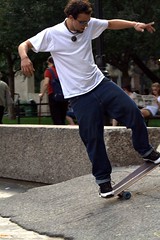
|
|
Corner (79 Washington Sq E): Paulette Goddard Hall.
The AIA Guide pronounces this NYU building "dour and
delightful."
Goddard, an actress best rembered for her
role in Modern Times, left $20 million
to NYU when she died in 1990.
45 W 4th: Violet Cafe
39: The address of stained-glass
artist
John LaFarge's glass factory
35 (corner): NYU's Education Building. Includes the
Frederick Loewe Theater, named for the composer of Camelot and
Brigadoon; the lobby features a Musical Theater Hall of Fame.
|
|
31 (corner): Campus Eatery
25: NYU's Student Life Center

15 (corner): The music club Bottom Line opened here in 1974. Some of Bruce Springsteen's first shows were here. Other musicians who played here include Patti Smith, Lou Reed, the Police, Prince, Neil Young, Hall & Oates, Billy Joel, Laura Nyro, Linda Ronstadt, Joan Baez.
Driven out of business in 2004 by landlord NYU's rent demands.
|
South:
14 (corner): Dojo's, very affordable Asian-y
diner, is on the ground floor of an eclectic 1890s building.
6: Pamela's Bake Shop
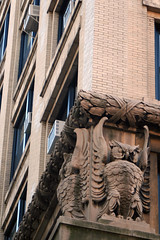
Corner (693 Broadway): Merchants Building has Bath & Bodyworks
on ground floor. Note scary owls on 4th floor.
|
|
|
North:
Brookdale Center

1 (block): Hebrew Union College's
Brookdale Center houses the Jewish Institute of Religion. Built
1979; replaced No. 11, the location of
Gerde's Folk City, a major folk venue, in its prime years (1956-69).
Dylan played here April 1961, his first paid gig; this is where he met Joan Baez. Simon and Garfunkel also debuted here.
|
|
As a mob of 5,000 marched down Broadway during the
1863 Draft Riots,
facing some 200 police officers blocking their
path at Bleecker, other officers attacked the column
from both sides at 4th Street, dispersing the crowd
with clubs.
|
South:
Silk Building
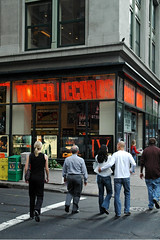
14 (block):
Above what used to be Tower Records is a luxury residential
building that has been home to Cher, Rob Lowe, Tom
Cruise and Nicole Kidman,
Keith Richards, Britney Spears and other celebs.
The east end of the former Tower is Will Smith's one-customer video
store in I Am Legend.
|
|
|
North:
1 (corner): French Connection UK and and Aldo shoes
are on the ground floor of the
Audubon Building, HQ of the environmental society;
building supposed to be model of energy efficiency. Was the Schermerhorn Building.

15: Was
Other Music, originally an alternative
to Tower, but it outlasted it by several years before closing
in 2016. Members of the band Animal Collective worked here.
Corner (400 Lafayette): 1888 loft building
|
|
South:
Corner: This used to be Tower Video, and
Tower Books used to be upstairs.
34: Swift's Hibernian Lounge, literate Irish pub
features Jonathan Swift memorabilia, including a pulpit from
the Rev. Swift's parish.
36: Aroma, little wine bar
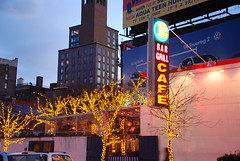
40 (cor-ner): Bowery Bar (aka B-Bar); when it first moved in in 1994,
this
former Gulf station was seen as a model-ridden
plague on the neighborhood. As the Bowery continues to
gentrify, its presence here seems less and less odd.
|
|
|
North:
DeVinne Press Building
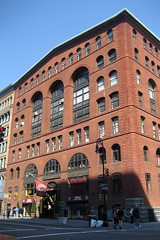
Corner (393 Lafayette): The AIA Guide raves about this
"magnificent pile," built in 1886.
25: This was an early address of the
Socialist Labor Party.
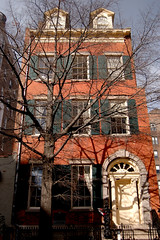
29: The house was built in 1832 for Joseph
Brewster, but was the home for many years of
Seabury Tredwell, a merchant so conservative in his
tastes that he was said to be the last man in
New York to wear a pigtail. Having got the house
the way he wanted it in
the 1830s, he kept it exactly that way, as did
his daughter Gertrude, who
lived here for 93 years until her death in 1933.
 (Reports that she inspired Catherine Sloper, the heroine of
Henry James' Washington Square, are apparently fanciful.)
When the house was recognized as essentially a
century-old time capsule,
it was turned into a museum.
(Reports that she inspired Catherine Sloper, the heroine of
Henry James' Washington Square, are apparently fanciful.)
When the house was recognized as essentially a
century-old time capsule,
it was turned into a museum.
(There's no evidence that Seabury Tredwell owned slaves, as the
Songlines have erroneously claimed.)
27: Plans to build a nine-story hotel at this long-vacant address have evoked fears that construction could damage the Merchants House.
Samuel Treadwell Skidmore House
37: Belonged to a cousin of Seabury Tredwell, who owned the Merchant's House.
Desperately in need of restoration, it was fixed up by the builders of 2 Cooper Square in 2010
as part of a zoning deal.
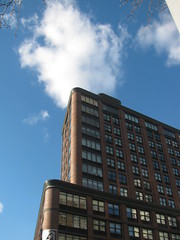
Corner (2 Cooper Square): A luxury apartment building built in 2010 in the retro
faux-industrial style of the Bowery Hotel. It's actually pretty nice-looking—but perhaps
not nice enough to charge up to $20,000 for a month's rent, as it
reportedly tried to do. Ashley Greene, a supporting actor in the Twilight films, has reportedly lived here.
|
|
South:
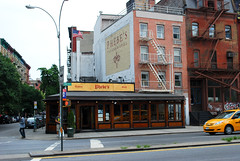
Corner (359 Bowery): Phebe's Tavern & Grill
opened in 1969; it served as an Off-Off-Broadway
scene and a post-CBGB's hangout for the punk movement.
For a while it was styling itself as ''Fuel at Phebe's.''
58: The
4th Street Food Co-Op was founded
in 1995, the successor to the Good Food Co-op, which
began in 1973.
60: Barbara Shaum, custom-made sandals
and other handcrafted leather since the 1960s.
62: This 1889 building houses
Rod Rogers Dance Theater and the Duo
Multicultural Arts Center, showcasing
Latino playwrights, directors and actors.
64: Was Labor Lyceum, worker education
and social center; Volkszeitung, a German-language
labor paper, was published here. The
International Ladies' Garment
Workers Union was founded here in 1900.
It later served as HQ for the Industrial Workers of the World.
Since 1990, it's been home to the experimental
theater company Downtown Arts.
66-68: LaMama Annex is in the former New-York
Turn-Verein, or "Gymnastics Club''; known as the Turn Hall,
it was organized in 1849 for "mental and physical education and
for the relief of members in case of sickness or distress."
The Witch, first professional Yiddish play in U.S., was produced here 1882,
foreshadowing the rise of Second Avenue as the Jewish theater district.
From 1925-1937 it was the Ukranian Labor Home, with the building's
theater dubbed the Manhattan Lyceum. In 1938 the building became
a dancehall named Manhattan Plaza, a name still on
the facade.
From 1956 until 1971 it was a film/TV
center called Biltmore Studios, aka ABC Stage City,
where such films as Cop Killer, Mag Dog Coll,
Coogan's Bluff and Hester Street were shot,
along with TV shows like Naked City and NYPD.
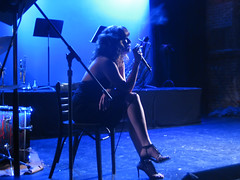
74A: Early off-off-Broad-way theater company,
founded in 1961 by Ellen ''La Mama'' Stewart. Andy Warhol's Pork was first produced here in 1971.
78: East Fourth Street, restaurant
82: From 1958 until 1978, this was
Club 82, mobbed-up drag bar that was an important venue for the first wave of punk/new wave; the New York Dolls, Television, Debbie Harry (pre-Blondie) all played here, to audiences that included David Bowie and Lou Reed. In the late 1980s/early 1990s it was Woody's, a bar owned
Woody's: Ron Wood The Chills, Eleventh Dream Day
Now it's
The Bijou, which shows old movies to gay patrons who
aren't watching them.
84 (corner): Belcourt, Parisian bistro, was
for many years Frutti di Mare (''Fruit of the
Sea''), fish-oriented Italian.
|
|
|
North:
Corner (200 E 5th): Evelyn & Louis Green
Residence, a project of the
Jewish Association
for Services for the Aged.
59: Women's One World, feminist theater group,
moved here to an abandoned doll factory in 1985.
67: Cuppa Cuppa Coffee, a LaMama hangout
69:
Pageant Print Shop, specializing
in old maps and other prints. Founded in 1946 on
Booksellers' Row, in a
earlier incarnation it was featured in the Woody Allen film
Hannah and Her Sisters, as well as in Neil Simon's
Chapter Two.
77: Meadowsweet Herbal Apothecary
79: The Truck & Warehouse Theater was
opened here in 1969 in a former warehouse--
founded by Bruce Mailman, owner of Phebe's.
The red mohair seats, interlaced with gold thread,
were bought cheaply after being rejected by the
Metropolitan Opera. The New York Theatre Strategy was
here for the 1974-75 season; Charles Ludlam's Ridiculous Theatrical Company
briefly played here about that time. In 1978, the space was taken over by
the Fourth Wall Political Theatre, affiliated with the cultlike
Sullivan Institute, which stayed until 1991.
New York Theater Workshop took up residence
here in 1993, and went on to premiere Rent and Dirty Blonde.
83: The Fourth Street Theater opened here
in 1954. From 1962-65 it housed the company Writer's Stage.
New Dramatists were here from 1965-69, and the Playwrights Unit,
founded by Edward Albee, was here from 1969 until it folded in 1970.
The Players Workshop called it home in 1971-73, followed by
Wonderhorse Theatre from 1973-83.

85: Literary hangout, complete with
anthology.
Used to be the Ukrainian Labor Home, a
pro-Soviet hangout; upstairs was earlier the
Palm Casino, owned by Lucky Luciano. Spaces include
the Kraine Theater and the Red Room. Downstairs is
the East Village Music Store,
selling new and used instruments.
87: Cucina di Pesce (''Fish Kitchen''),
was a twin of Frutti di Mare across the street.
|
|
South:
Corner (68 2nd Ave): Two by Four--referring
to the cross streets--
was The Bar, gay dive with
biker vibe; dates back to late 1970s.
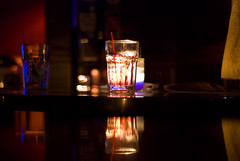
86: The Boiler Room, dark, popular gay bar
88: Dolphin Fitness
96: East Village Foot Care Center
98: Healthfully Organic Market
108: Cicciolino; the name of this
Italian restaurant means "little cute thing"--
and it is.
110: Euzkadi, Basque restaurant
116: Jeollado, Japanese/Korean sushi.
Includes a video-screening room.
124: Social Tees,
message T-shirts whose proceeds go to animal shelters.
128: Borobudur, tasty, affordable
Indonesian named for a 9th Century Buddhist pyramid.
|
|
|
North:
Corner (72 2nd Ave): Art Deco Fleet Bank is former
Industrial National Bank (c. 1926); note original name
on south wall.
97: Cabrini Medical Center
113: Manhattan School for Career Development,
a public high school, features murals by neighborhood
grafitti artist Chico, who went to school here.
125: Best Chinese Foot & Back Rub;
Village Divers
131: Unique Flowers
133: Village Computer
|
|
South:
Corner (121 E 3rd): A
pre-K-through-5th-grade school founded in 1991
to "give children the experiences and opportunities to become
good citizens of a democratic society."
Ageloff Towers
172 (corner): This apartment building with cool Assyrian detail
was built by developer Samuel Ageloff for
$2.5 million in 1928, hoping to lure the affluent to what was then the Lower East Side;
the 1929 stock market
crash put a crimp in this plan, but it's not true, as the Songlines
once reported, that Ageloff committed suicide by jumping off his tower.
His grandson informs me that the developer bounced back from the
Depression, "enjoyed life very, very substantially," and lived
to be 92.
Ground floor used to be Cucino Cuzco,
Peruvian restaurant--now a bank.
|
|
|
North:
Village View Houses
Mitchell-Lama co-op whose seven towers
were built in 1964.
|
|
S <===
AVENUE A
===> N
The western boundary of Alphabet City
|
South:
Corner: Key Food has maddening
checkouts--though the price and selection aren't
bad.
220: Holy Child Middle School/Cornelia Connelly Center for Education.
Connelly, a nun, founded the
Society of the
Holy Child Jesus.
Houses (at 220A) the Connelly Theater, a 19th Century stage, as
well as the
Metropolitan Playhouse, a company noted for
rediscovering forgotten American plays.
Also found here is the Catholic Big Sisters/Lower East Side Girls Club.
230:
Madonna lived here in 1978,
when she was poor and so was the neighborhood.
234: Ma-Ya, Thai tapas bar;
Perbacco Cafe, Italian tapas.
236: Bellet Construction
240: Lotus Salon.
Handsome Dick Manitoba
of The Dictators lived at this address
when he first moved to the East Village.
Corner (50 Ave B): Avenue B Grocery Store
|
|
|
North:
Corner (58 Ave A): Discount Fine Wine
& Champagne's
193: Go Girl Salon
199: Venus Modern Body Arts,
famous body-piercing salon.
203: Eugenia Kim Hats claims
Jennifer Lopez and Janet Jackson as clients.
205: Assenzio; the Sardinian
wine bar's name means
"absinthe," but they use southernwood
as a non-brain-damaging alternative.
207: An unusual wood facade.
211: Mamlouk, prix fixe Mideastern
215: Yale Apartments; houses
Last Rites Tattoo Theater and Curio Shoppe,
elaborate and disturbing skin art. Now also
(instead?) In Vino, bar with hundreds of wines
from the south of Italy.
233: Ultra Hair Salon promises not to
schedule your appointment for the same time
as your ex's.
235: In the Marvel show Hawkeye, Clint and Kate hide out here at Kate's aunt's apartment. Was Aquarian Foundation, "The Church
of Tomorrow Here Today."
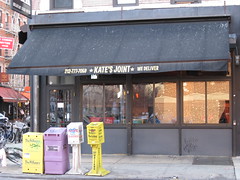
Corner (58 Ave B): Was Kate's Joint,
vegetarian restaurant serving American comfort
food; owner/chef Kate Halpern is a meat-eater
who avoids serving meat for fear of "karmic fallout."
|
|
South:
Corner (53 Ave B): East 4th Deli
246: Otnoob, red, white and green
apartment building decorated with sun, moon
and stars.
256: Emmanuel Spanish Baptist Church
270: Tu Pueblo Batay, "your community
garden" since 1982, aka Generation X Youth
Cultural Garden
300 (corner): Gothic revival building
|
|
|
North:
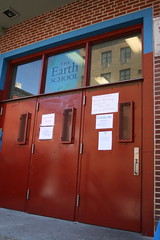
Corner: A public elementary school
opened in 1992 with an environmental and peace focus.
269: George Daly House, residential
mental health center. Was ABC Community Center.
281: The Winner's Circle Garden
289: Road to Damascus Christian Church, Pentacostal

Corner: The Secret Garden; it's not very secret,
being right on the corner, so presumably
the name is a reference to the Frances Hodgson Burnett
book in
which restoring a garden brings life
back to a community.
|
|
South:
Corner: Fine Fare supermarket.
"To the ladies at Fine Fare Supermarket, just about everybody is
'Mama'"--Voice
Tranquilidad, community garden
332: Was Chama, UFO-oriented tearoom/performance space;
now Amazonas, Brazilian cafe.
Orchard Alley, community garden
|
|
|
North:
Corner (54 Ave C): Mountains of Yaffa Supermarket.
I believe the name refers to
Yafa in Yemen.
329: Director
George Cukor (The Philadelphia Story, Adam's Rib, etc.) was born on this site,
July 14, 1899.
Jardin el Paraiso, community garden
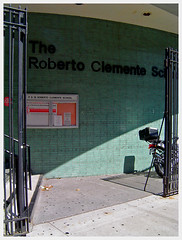
333: PS 15:
Roberto Clemente School. Named for the Puerto Rican
baseball player who died delivering earthquake
relief to Nicaragua.
345: San Isidoro y San Leandro Orthodox
Catholic Church of the Hispanic Rite; named for brothers who were
successive bishops in Seville, c. 600 AD.
Originally a Russian Orthodox Church, built c. 1895.
355: Dry Dock, a turn-of-the-20th-Century tenement
named for the neighborhood's former role as
a center for ship repair.
|
|
"You'll caper like a stupid clown when you chance
to see... 4th Street and D!"--Tony Bennett on The Simpsons
|
Lillian Wald Houses
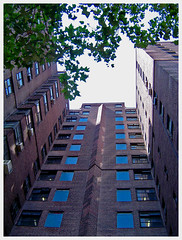
Public housing project named for Lillian D. Wald
(1867-1940), who provided aid to the Lower East Side
through the Henry Street Settlement and the Visiting Nurses
Society. She fought for women's suffrage and against child
labor, and help start the Women's Trade Union League.
Margaret Sanger of Planned Parenthood was her protegee.
When Fourth Street continued to the east, novelist
Jerome Weidman, author of I Can Get It for You Wholesale,
was born at No. 390 on April 4, 1913.
|
|
|
